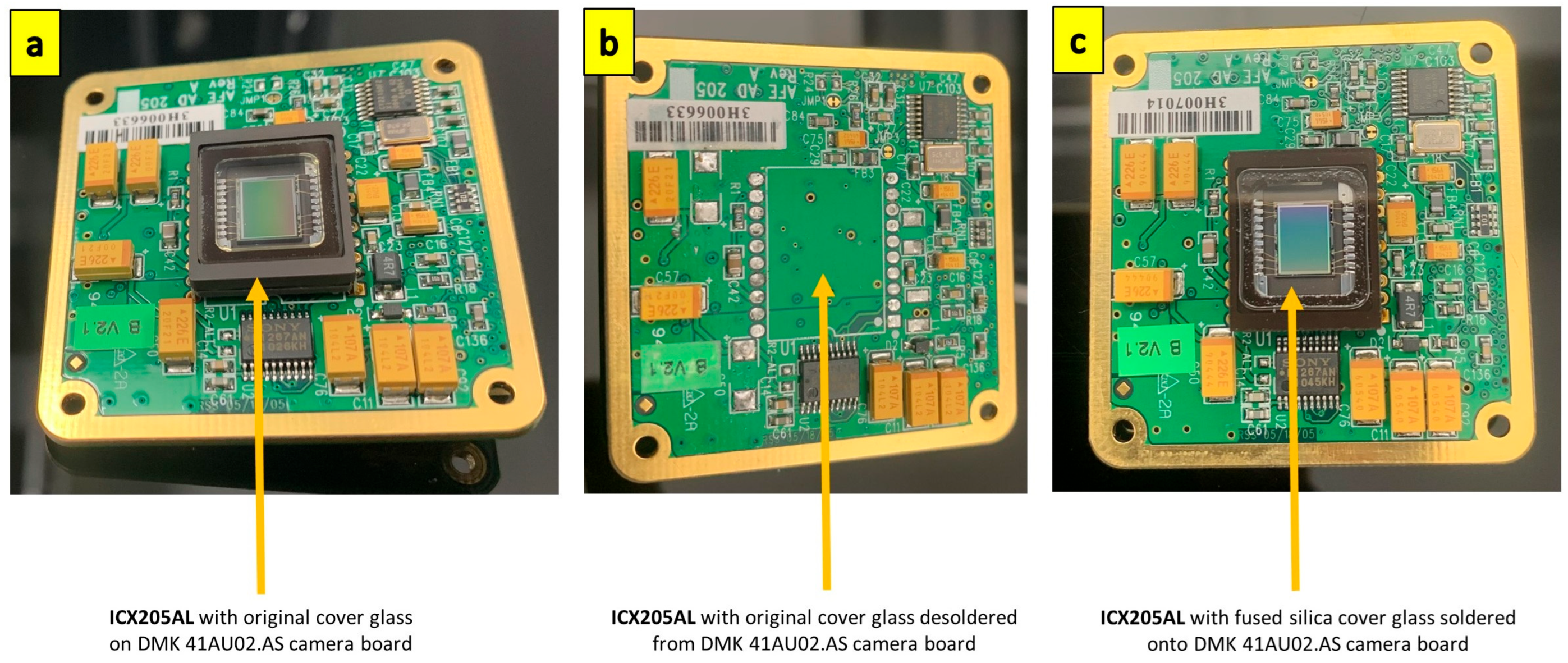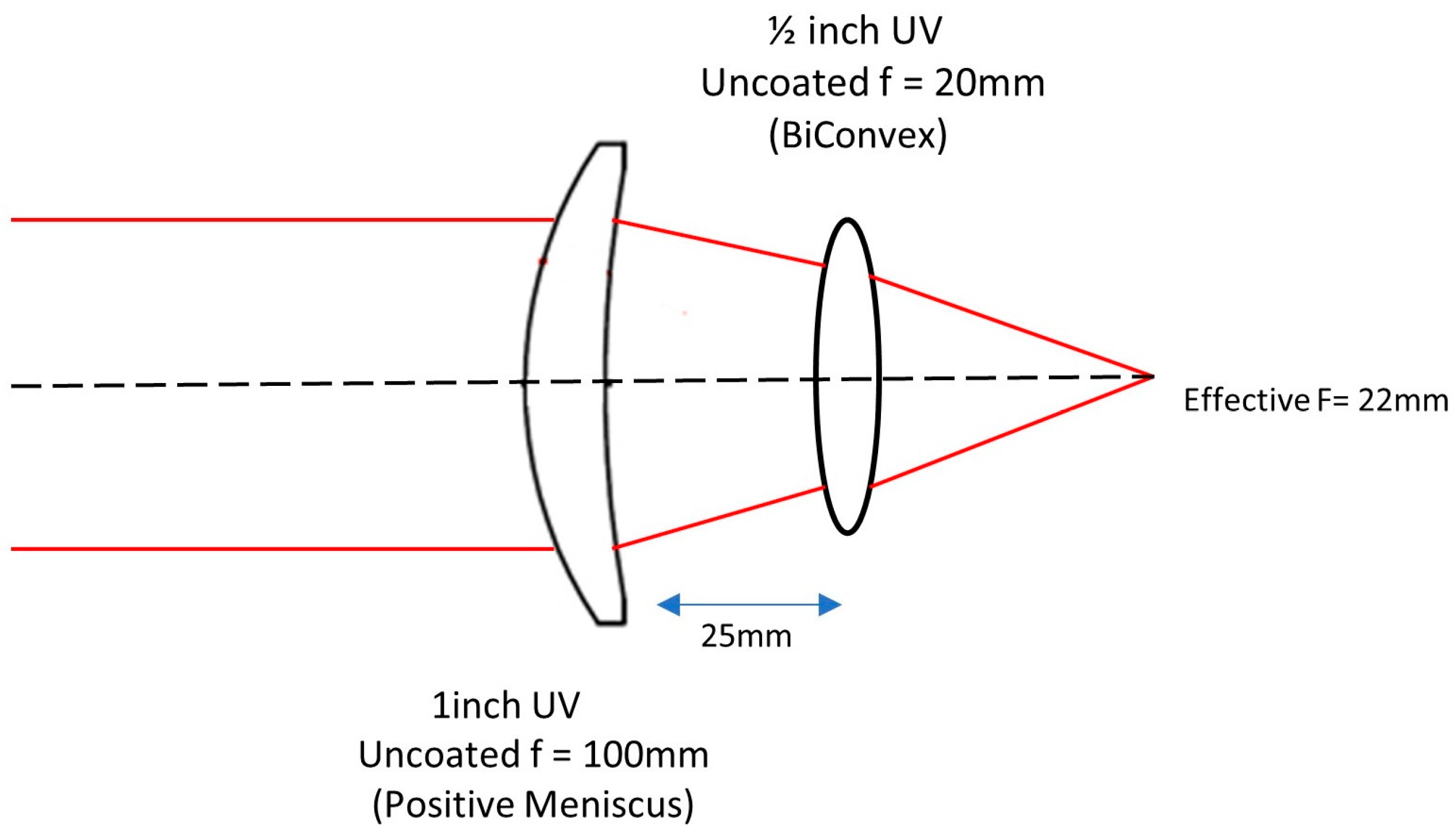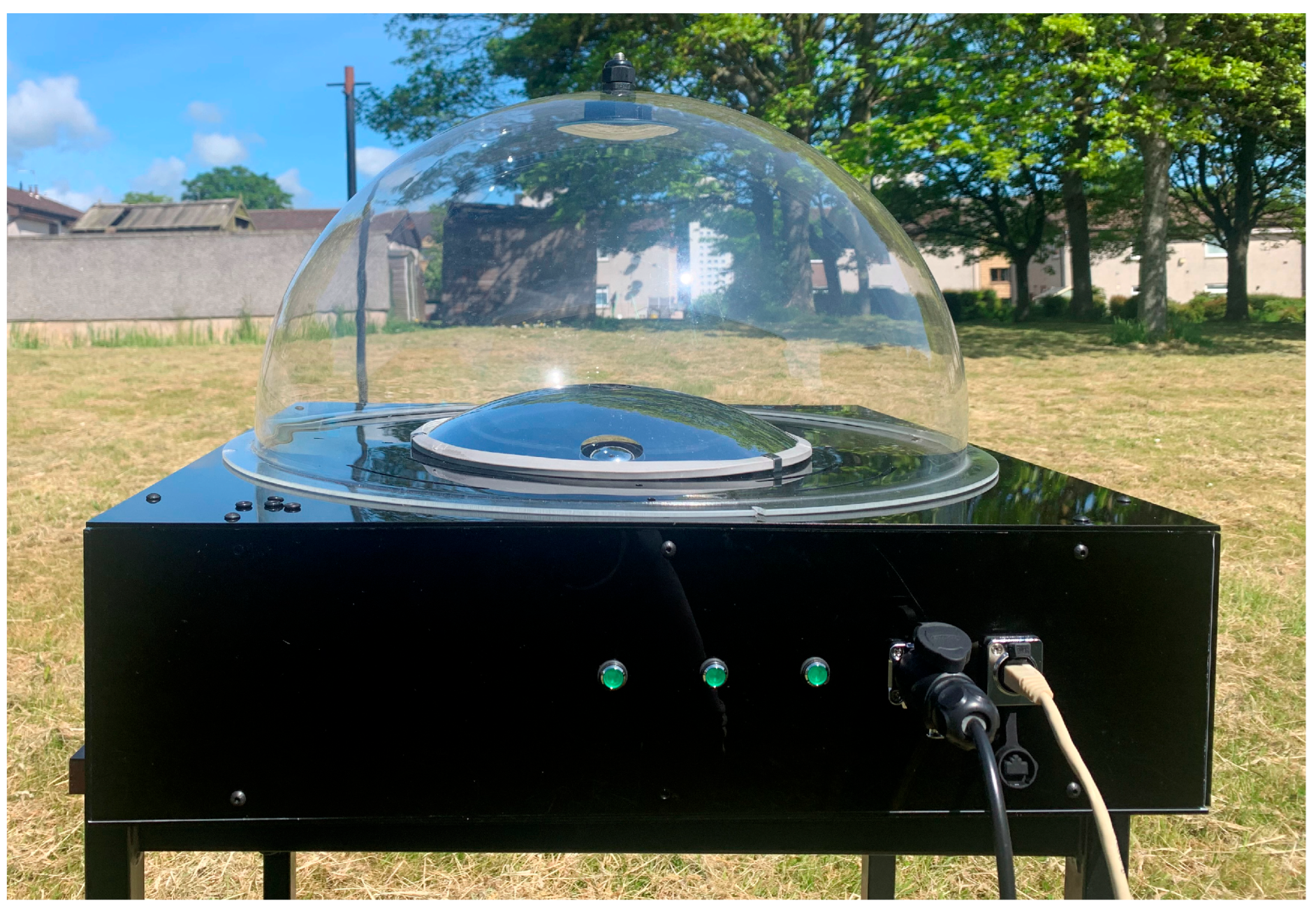Design and Development of an Ultraviolet All-Sky Imaging System
Abstract
1. Introduction
2. Construction
2.1. UV Camera Sensor
2.2. UV-Transparent Lens
2.3. Catadioptric System Assembly
3. Results and Discussion
4. Conclusions
Author Contributions
Funding
Institutional Review Board Statement
Informed Consent Statement
Data Availability Statement
Acknowledgments
Conflicts of Interest
References
- Barnard, E.E. A Photographic Atlas of Selected Regions of the Milky Way; Cambridge University Press: Cambridge, UK, 2011. [Google Scholar]
- Wood, R.W. Refraction of Light. In Physical Optics; Macmillan Co., Ltd.: New York, NY, USA, 1911; pp. 66–68. [Google Scholar]
- Hill, R. A lens for whole sky photographs. Q. J. R. Meteorol. Soc. 1924, 50, 227–235. [Google Scholar] [CrossRef]
- Deppermann, C.E. An improved mirror for photography of the whole Sky. Bull. Am. Meteorol. Soc. 1949, 30, 282–285. [Google Scholar] [CrossRef][Green Version]
- The UNESCO Courier. International Geophysical Year; UNESCO: Paris, France, 1957; pp. 26–27. [Google Scholar] [CrossRef]
- Gadsden, M. Reflecting all-sky cameras. J. Br. Astron. Assoc. 1978, 88, 570–577. [Google Scholar]
- Davis, T.N.; Elvey, C.T. Construction of an All-Sky Camera; Geophysical Institute at the University of Alaska: Fairbanks, AK, USA, 1995; Available online: https://scholarworks.alaska.edu/handle/11122/3557 (accessed on 19 August 2023).
- McArthur, L.B.; Hay, J.E. On the anisotropy of diffuse solar radiation. Bull. Am. Meteorol. Soc. 1979, 59, 1442–1443. [Google Scholar]
- Mende, S.B.; Eather, R.H. Monochromatic all-sky observations and auroral precipitation patterns. J. Geophys. Res. 1976, 81, 3771–3780. [Google Scholar] [CrossRef]
- Long, C.N.; Sabburg, J.M.; Calbó, J.; Pagès, D. Retrieving cloud characteristics from ground-based daytime colour all-sky images. J. Atmos. Ocean. Technol. 2006, 23, 633–652. [Google Scholar] [CrossRef]
- Grossberg, M.D.; Nayar, S.K. The RAXEL imaging model and Ray-based calibration. Int. J. Comput. Vis. 2005, 61, 119–137. [Google Scholar] [CrossRef]
- Gonçalves, N.; Araújo, H. Estimating parameters of noncentral catadioptric systems using bundle adjustment. Comput. Vis. Image Underst. 2009, 113, 11–28. [Google Scholar] [CrossRef]
- Xiang, Z.; Dai, X.; Gong, X. Noncentral catadioptric camera calibration using a generalized unified model. Opt. Lett. 2013, 38, 1367. [Google Scholar] [CrossRef]
- Piacentini, R.D.; Cede, A.; Bárcena, H. Extreme solar total and UV irradiances due to cloud effect measured near the summer solstice at the high-altitude Desertic Plateau Puna of Atacama (Argentina). J. Atmos. Sol. Terr. Phys. 2003, 65, 727–731. [Google Scholar] [CrossRef]
- Mims, F.M., III.; Frederick, J.E. Cumulus clouds and UV-B. Nature 1994, 371, 291. [Google Scholar] [CrossRef]
- Estupiñán, J.G.; Raman, S.; Crescenti, G.H.; Streicher, J.J.; Barnard, W.F. Effects of clouds and haze on UV-Bradiation. J. Geophys. Res. 1996, 101, 16807–16816. [Google Scholar]
- Schafer, J.S.; Saxena, V.K.; Wenny, B.N.; Barnard, W.; DeLuisi, J.J. Observed influences of clouds on ultraviolet-Bradiation. Geophys. Res. Lett. 1996, 23, 2625–2628. [Google Scholar] [CrossRef]
- Sabburg, J.; Wong, J. The effect of clouds on en-hancing UVB irradiance at the earth’s surface: A one year study. Geophys. Res. Lett. 2000, 27, 3337–3340. [Google Scholar] [CrossRef]
- Sabburg, J.M.; Parisi, A.V.; Kimlin, M.G. Enhanced spectral UV irradiance: A 1-year preliminary study. Atmos. Res. 2003, 66, 261–272. [Google Scholar] [CrossRef]
- Sabburg, J.M.; Long, C.N. Improved Sky Imaging for studies of enhanced UV irradiance. Atmos. Chem. Phys. 2004, 4, 2543–2552. [Google Scholar] [CrossRef]
- Baumgarten, G.; Thomas, G.E. The importance of ice particle shape on UV measurements of polar mesospheric clouds: SBUV/2 observations. J. Atmos. Sol. Terr. Phys. 2006, 68, 78–84. [Google Scholar] [CrossRef]
- Wilkes, T.; Pering, T.D.; McGonigle, A.J.S.; Tamburello, G.; Willmott, J.R. A low-cost smartphone sensor-based UV camera for volcanic SO2 Emission Measurements. Remote Sens. 2017, 9, 27. [Google Scholar] [CrossRef]
- Wu, K.; Zhang, Z.; Guo, J.; Hu, X.; Li, J.; Li, F.; He, W. Effect of UV scattering on detection limit of SO2 cameras. Remote Sens. 2023, 15, 705. [Google Scholar] [CrossRef]
- Li, J.; Carlson, B.E.; Yung, Y.L.; Lv, D.; Hansen, J.; Penner, J.E.; Liao, H.; Ramaswamy, V.; Kahn, R.A.; Zhang, P.; et al. Scattering and absorbing aerosols in the climate system. Nat. Rev. Earth Environ. 2022, 3, 363–379. [Google Scholar] [CrossRef]
- Loeb, A.; Laukien, F.H. Overview of the Galileo project. J. Astron. Instrum. 2023, arXiv:2209.02479. [Google Scholar] [CrossRef]
- Narayanan, D.L.; Saladi, R.N.; Fox, J.L. Review: Ultraviolet radiation and skin cancer. Int. J. Dermatol. 2010, 49, 978–986. [Google Scholar] [CrossRef] [PubMed]
- Sony IMX487 Ultraviolet Scientific Grade Camera—XIMEA. Available online: https://www.ximea.com/en/products/xilab-application-specific-custom-oem/sony-imx487-ultraviolet-scientific-grade-camera?responsivizer_template=desktopltraviolet+scientific+grade+camera (accessed on 15 August 2023).
- Lucid Vision Labs tritonTM tri081s-cc, Sony IMX546, 8.1 MP, Color Camera—Edmund Optics Worldwide. Available online: https://www.edmundoptics.co.uk/p/lucid-vision-labs-tritont-tri081s-cc-sony-imx546-81mp-color-camera/45507/ (accessed on 15 August 2023).
- Ziad, A.; Chabé, J.; Fanteï-Caujolle, Y.; Aristidi, E.; Renaud, C. CATS: A New Station for a Complete Characterization of Atmospheric Turbulence. AO4ELT5, 2017, Tenerife, Spain. Available online: https://hal.science/hal-02477428/ (accessed on 19 August 2023).
- Chabé, J.; Ziad, A.; Fantéï-Caujolle, Y.; Aristidi, É.; Renaud, C.; Blary, F.; Marjani, M. The Calern atmospheric turbulence station. In Proceedings of the SPIE 9906, Ground-Based and Airborne Telescopes VI, 99064Z, Edinburgh, UK, 27 July 2016. [Google Scholar] [CrossRef]
- Lesser, M. Charge-coupled device (CCD) image sensors. In High-Performance Silicon Imaging; Woodhead Publishing: Sawston, UK, 2014; pp. 78–97. [Google Scholar] [CrossRef]
- ICX205 Datasheet (PDF)—Sony Corporation, Alldatasheet.com—Electronic Parts Datasheet Search. Available online: https://www.alldatasheet.com/datasheet-pdf/pdf/47427/SONY/ICX205.html (accessed on 7 May 2023).
- Crowther, J. Monochrome camera conversion: Effect on sensitivity for multispectral imaging (ultraviolet, visible, and infrared). J. Imaging 2022, 8, 54. [Google Scholar] [CrossRef] [PubMed]
- LDP LLC—UV Lenses. Available online: https://maxmax.com/uv-lenses (accessed on 15 August 2023).
- 105 mm f/4.5 UV Nikkor AIS. Grays of Westminster Online Shop. 2022. Available online: https://shop.graysofwestminster.co.uk/product/105mm-f-4-5-uv-nikkor-ais (accessed on 15 August 2023).
- Canon EF-S 60 mm F2.8 USM MACRO A3061303—Aperture UK. Available online: https://www.apertureuk.com/canon-ef-s-60mm-f28-usm-macro-a3061303.html (accessed on 15 August 2023).
- LM60HC-IR—1” 5MP 60 mm F2.0 C-mount lens—Torchlight Vision. Available online: https://www.torchlightvision.com/en-gb/products/lm60hc-ir (accessed on 15 August 2023).
- Franke, S.; Lange, H.; Schoepp, H.; Witzke, H.D. Temperature dependence of VUV transmission of synthetic fused silica. J. Phys. D Appl. Phys. 2006, 39, 3042–3046. [Google Scholar] [CrossRef]
- Griot, CVIM. Optical Components: Finding Your Way through the Maze, Photonics Media. 2006. Available online: https://www.photonics.com/Articles/Optical_Components_Finding_Your_Way_Through_the/a25455 (accessed on 6 May 2023).
- Red Rejection UV Filter/340 nm: Asahi Spectra USA Inc. Red Rejection UV Filter/340 nm|Asahi Spectra USA Inc. Available online: https://www.asahi-spectra.com/opticalfilters/detail.asp?key=XRR0340 (accessed on 8 May 2023).
- Martín-Torres, J.; Zorzano, M.P.; Soria-Salinas, Á.; Nazarious, M.I.; Konatham, S.; Mathanlal, T.; Ramachandran, A.V.; Ramírez-Luque, J.A.; Mantas-Nakhai, R. The HABIT (Habitability: Brine Irradiation and Temperature) environmental instrument for the Exomars 2022 surface platform. Planet. Space Sci. 2020, 190, 104968. [Google Scholar] [CrossRef]
- Wacker, S.; Groebner, J.; Zysset, C.; Diener, L.; Tzoumanikas, P.; Kazantzidis, A.; Vuilleumier, L.; Stoeckli, R.; Nyeki, S.; Kaempfer, N. Cloud observations in Switzerland using hemispherical sky cameras. J. Geophys. Res. Atmos. 2015, 120, 695–707. [Google Scholar] [CrossRef]
- Tien, C.-L.; Chiang, C.-Y.; Sun, W.-S. Design of a miniaturized wide-angle fisheye lens based on deep learning and Optimization Techniques. Micromachines 2022, 13, 1409. [Google Scholar] [CrossRef]












| Image Sensor Configuration | Interline Back-Illuminated CCD |
|---|---|
| Image size | 8 mm diagonal (7.959 mm effective) |
| Total pixel count | 1434 (H) × 1050 (V), 1.50 MP |
| Total effective pixel count | 1392 (H) × 1040 (V), 1.45 MP |
| Total active pixel count | 1360 (H) × 1024 (V), 1.40 MP |
| Chip size | 7.60 mm (H) × 6.20 mm (V) |
| Pixel size | 4.65 μm (H) × 4.65 μm (V) |
| Substrate material | Silicon |
Disclaimer/Publisher’s Note: The statements, opinions and data contained in all publications are solely those of the individual author(s) and contributor(s) and not of MDPI and/or the editor(s). MDPI and/or the editor(s) disclaim responsibility for any injury to people or property resulting from any ideas, methods, instructions or products referred to in the content. |
© 2023 by the authors. Licensee MDPI, Basel, Switzerland. This article is an open access article distributed under the terms and conditions of the Creative Commons Attribution (CC BY) license (https://creativecommons.org/licenses/by/4.0/).
Share and Cite
Mathanlal, T.; Martin-Torres, J. Design and Development of an Ultraviolet All-Sky Imaging System. Sensors 2023, 23, 7343. https://doi.org/10.3390/s23177343
Mathanlal T, Martin-Torres J. Design and Development of an Ultraviolet All-Sky Imaging System. Sensors. 2023; 23(17):7343. https://doi.org/10.3390/s23177343
Chicago/Turabian StyleMathanlal, Thasshwin, and Javier Martin-Torres. 2023. "Design and Development of an Ultraviolet All-Sky Imaging System" Sensors 23, no. 17: 7343. https://doi.org/10.3390/s23177343
APA StyleMathanlal, T., & Martin-Torres, J. (2023). Design and Development of an Ultraviolet All-Sky Imaging System. Sensors, 23(17), 7343. https://doi.org/10.3390/s23177343







